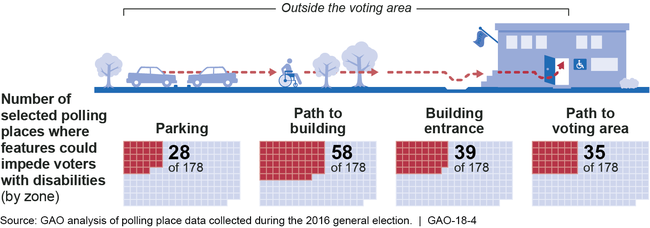Voters with Disabilities: Observations on Polling Place Accessibility and Related Federal Guidance [Reissued on December 4, 2017]
Highlights
What GAO Found
GAO examined a nongeneralizable sample of 178 polling places during early in-person voting and on Election Day 2016. At these polling places, GAO examined a number of features outside and inside the voting area. Outside the voting area, GAO was able to examine features at all 178 polling places and found that 60 percent (107) had one or more potential impediments. The most common were steep ramps located outside buildings, lack of signs indicating accessible paths, and poor parking or path surfaces (see figure).

Of the 178 polling places, GAO was able to fully examine voting stations inside the voting area at 137. Of these 137 polling places, 65 percent (89) had a voting station with an accessible voting system that could impede the casting of a private and independent vote. For example, some voting stations were not set up to accommodate people using wheelchairs, which might have required someone else to help them vote. GAO was not able to fully examine voting stations at 41 polling places due to voting area restrictions.
Most states that completed GAO's survey reported taking actions during the 2016 general election to facilitate voting access for voters with disabilities, including having accessibility requirements, providing election worker training, and conducting oversight. For example, 44 states reported having accessibility standards for polling places, and 48 states reported conducting at least one oversight activity, such as analyzing accessibility complaints.
The Department of Justice's (DOJ) guidance does not clearly specify the extent to which certain federal accessibility requirements are applicable to early in-person voting, an increasingly common form of voting at a designated location before Election Day. In this context, GAO found some variation in the extent to which accessible voting systems are provided for early in-person voting. GAO found one county without accessible voting systems at five of its early in-person voting locations. Also, officials from four states said that these systems are not required by their state laws for in-person voting before Election Day. Given that voting has evolved since federal accessibility requirements were enacted, studying the implementation of these requirements in the context of early in-person voting could position DOJ to determine the extent to which any changes to its guidance are necessary.
Why GAO Did This Study
Federal law generally requires all polling places for federal elections to be accessible to all voters, and each polling place to have a system for casting ballots that is accessible for people with disabilities. GAO's work during the 2000 and 2008 general elections showed mixed results on polling place accessibility. GAO was asked to examine voting access for people with disabilities during the 2016 general election.
This report examines in-person voting before and on Election Day 2016. GAO examined (1) the extent to which selected polling places had features that might impede voting access; (2) actions states took to facilitate voting access; and (3) guidance DOJ provided on the extent to which federal accessibility requirements apply to early in-person voting. GAO examined features at a nongeneralizable sample of 178 polling places, identified by selecting 21 counties in 12 states and the District of Columbia (DC). Counties were selected for variation in population size, geographic location, and type of election administration. GAO did not assess legal compliance with federal or state laws. GAO also surveyed state election officials in 50 states and DC (with 98 percent responding); reviewed federal laws and guidance; and interviewed local, state, and federal officials.
Reissued on December 4, 2017
Recommendations
GAO recommends that DOJ study the implementation of federal accessibility requirements in the context of early in-person voting and, as necessary, make changes to existing guidance. DOJ generally agreed with GAO's recommendation.
Recommendations for Executive Action
| Agency Affected | Recommendation | Status |
|---|---|---|
| Department of Justice | The Attorney General should study the implementation of federal accessibility requirements in the context of early in-person voting and make any changes to existing guidance that are determined to be necessary as a result of the study. (Recommendation 1) |
The Department of Justice (DOJ) agreed with this recommendation, and reported in May 2021 that it had studied the federal accessibility requirements during several meetings between staff in its Voting Section and Disability Rights Section. It also highlighted the continuing close working relationship between the two sections in coordinating DOJ's law enforcement efforts and joint investigations involving voters with disabilities in the context of early in-person voting and other voting contexts. Given these efforts, and after studying the recommendation, DOJ determined that no changes were necessary to existing guidance. We determined that DOJ has taken actions to fully implement our recommendation.
|
